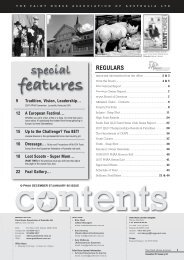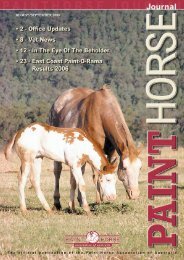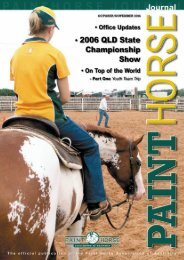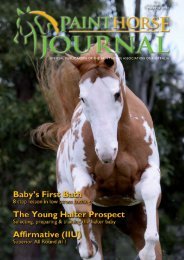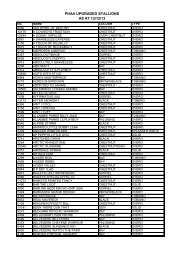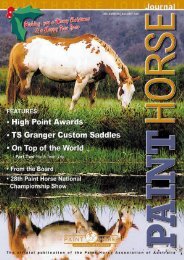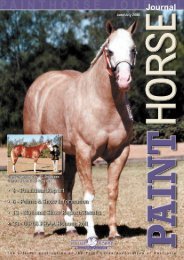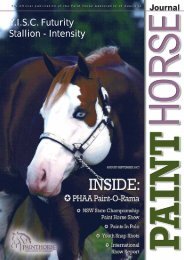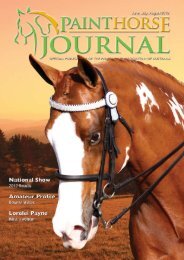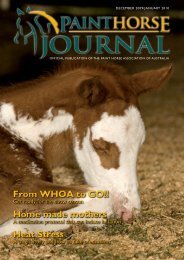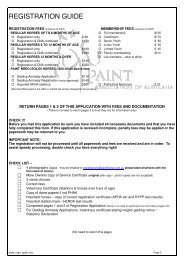PH - Paint Horse Association of Australia
PH - Paint Horse Association of Australia
PH - Paint Horse Association of Australia
Create successful ePaper yourself
Turn your PDF publications into a flip-book with our unique Google optimized e-Paper software.
~ feature ~<br />
Tesio was correct - grey in horses is not a "colour" or a "factor"<br />
- it is a "disease <strong>of</strong> the coat".<br />
STORY: ANGELA NEWTON FROM KERRY MORGAN B.A.DIP.ED - OCTOBER 24, 2003 (REVISED NOV 2, 2005)<br />
PERSPECTIVE TWO - (AS DISCUSSED FROM PREVIOUS ARTICLE)...<br />
Does any other animal go grey like a horse goes grey?<br />
There are animals that are grey in colour but they are born<br />
grey, there are shades <strong>of</strong> grey and agouti among cats, dogs,<br />
rabbits, goats, there are "blue" cows, there are even other<br />
colours in the horse that appear grey, such as blue roan,<br />
and roan associated with Appaloosa colouring. People lose<br />
their hair colour from middle to advanced age. But unique<br />
among animals, horses "go grey".<br />
A grey horse is can be born any colour, and the greying <strong>of</strong><br />
the coat begins some time after birth and progresses. Very<br />
aged grey horses are white, with or without a "fleabitten"<br />
effect. Breeders can usually identify a foal that will turn<br />
grey by the presence <strong>of</strong> grey hairs around the eyes. Only<br />
foals that have at least one grey parent can go grey, but<br />
conversely a foal with 2 grey parents may remain non-grey,<br />
even in breeds with a high percentage <strong>of</strong> homozygous greys<br />
such as the Lipizzanner.<br />
A grey horse has the usual complement <strong>of</strong> genes for colour<br />
and/or pattern inherited from both parents, but geneticists<br />
have long regarded the tendency to "grey out" as a factor<br />
that acts in addition to the genotype for coat colour. The<br />
inheritance pattern for grey follows Mendelian rules. It can<br />
be homozygous or heterozygous, and it is dominant in that<br />
if the animal carries one gene for the factor, the horse will<br />
appear grey. A grey horse must have at least one grey<br />
parent, ie the factor cannot be carried recessively.<br />
I believe that the "factor"<br />
that makes a horse go grey<br />
is in fact an inheritable<br />
dominant mutation which<br />
affects the skin and hair <strong>of</strong><br />
the grey horse, and which in<br />
its full expression is "grey<br />
horse melanoma".<br />
Gower (1999, p. 60)<br />
states the following:<br />
"Throughout the life <strong>of</strong> a<br />
grey, pigment is removed<br />
from the hair and<br />
redeposited in the gut or skin, and this is thought to be<br />
responsible for…the slow-growing deposits <strong>of</strong> pigment<br />
loosely termed ‘melanoma’.<br />
Fintl & Dixon (2001) refer to a 1972 survey by Stannard<br />
which indicated that "more than 80% <strong>of</strong> grey horses over<br />
15 years old were affected with such [melanotic] growths".<br />
In the same article, Yager et al (1993) is quoted as<br />
suggesting that all grey horses would eventually develop<br />
such lesions if they lived long enough.<br />
Drs Sutton and Coleman from Uni. Qld. studied 97 grey<br />
horses and 16 coloured horses at a pet food abattoir, and<br />
24<br />
The <strong>Paint</strong> <strong>Horse</strong> Journal<br />
February - March 2007



